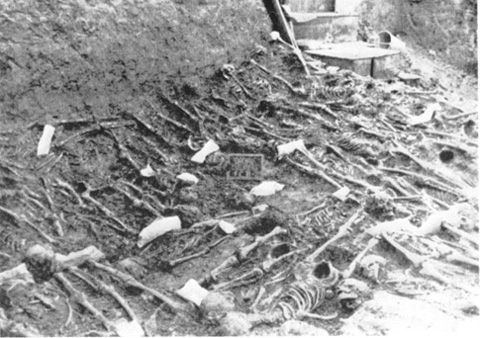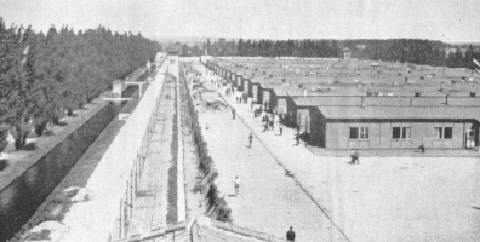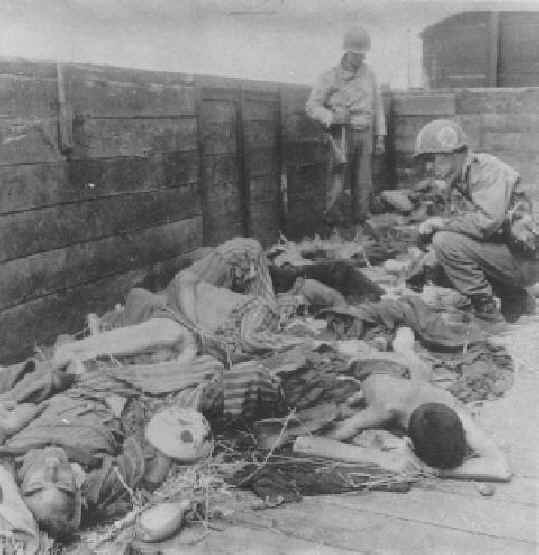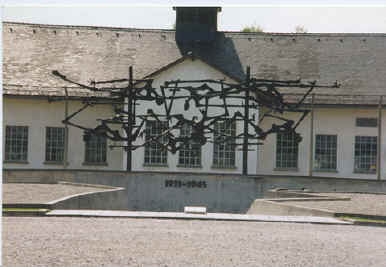
Dachau officially opened March 22, 1933. It was liberated in 1945. The people could not release prisoners because they may have agitated other people and organized groups when released. Dachau was located in upper Bavaria and North-East of Munich.
On the very first days the guards would brutally beat and murder the inmates. Close to the end of 1933, there were 4,821 registered prisoners in Dachau. By 1945 there were 206,206 registered prisoners. The total death count may never be known. Very many died in evacuation marches and death marches. So these deaths were never registered.

The guards would hang anyone who tried to escape, help anyone in escape, seeks outside contact by any means, transmits signals, or hide and climbed up on the roof of a hut or hid up in the trees. Initially they would bury the dead in ordinary graves, but the body count rose so they had to think of other plans for the bodies.
Records show that 6,223 bodies were exhumed from Leitenberg alone, and 1,124 from four other different places. By 1940 body disposal reached a critical point. Many of the dead were never registered. The unregistered will probably be never known. By 1941 there was well over 6,000 executed people. But there names never were registered.

In 1940 the first crematorium was made, by the North-west corner of the camp, and the only way of reaching it is a very small footbridge. The ovens were in a wooden shed surrounded by a group of trees. It was concealed very well, you can tell they chose it very carefully. And it was further isolated by a large drainage ditch, the camp wall, a barbed wire fence, and a huge ditch with swift flowing water. The crematorium is even hard to see to this day. In early 1942, the death rate would outstrip the capacity of the old crematorium. They put the manufacturers name on the furnace doors. The Nazi's drew up plans for a 4-furnace crematorium, in the early days it incorporated five gas chambers. Three months later the SS Headquarters in Berlin said to commerce construction for the crematorium the cost would be RM 150,000.
The new crematorium was completed in 1943. Four of the five gas chambers were for fumigation, and the other one was for homicidal purposes. And the name would be Baracke X.
'The oven of Dachau and other Nazi camps are not crematoriums.' An older crematorium would cremate one body at a time. `It has a heating cycle, an incineration cycle, a cooling cycle, and recovery of the ashes.` An oven that took bodies after bodies is more often called an incinerator. The cremations of cadavers, in the last case, had no cooling period or the recovery of ashes between cremations. The new corpses were simply fed into the ovens as the old ones were consumed.
The cost of the incinerator is quite lower than the cost of a crematorium, and the efficiency is considerably higher. Because coal and other resources were often in short supply, with the substantial increase with the number of cadavers to be incinerated. `The ovens were run continuously; many of the bodies were often burned together and the ashes were mixed together.`
They also started making better ovens that could hold 7 or 8 sometimes even 9 corpses. They had 4 ovens. The cremation lasted usually about 2 hours. The ashes would be preserved in urns. The guards would mix the ashes together, but later they got lazy and just quit filling the urns and the ashes were buried in the grounds of the crematorium.
|
|
Dachau was liberated in 1945 by the American troops. There were corpses piled enormously in the morgue of the new crematorium, and in front of the crematorium. They also found bodies around everywhere on the camp grounds and in the huts. Boxcars were filled with corpses by the hundreds. There is not a word that can explain such indecency.
The homicidal chamber could have been used for gassing the prisoners. It was pure murder and you can also tell the Nazis definitely intended to use homicidal gas chambers in Dachau. Because hey built and designed such a chamber in the camp of Dachau.
On the experimental gassing. Out of the Russian-campaign, Almost all of them were Jews. An estimated 900,000 people. `There were about 120,000 killed through the Nazi' Euthanasia actions.`
After the depression many companies needed workers without pay so they turned to the camps. Dachau slaves were forced to work at all sorts of factories; such as Ornier, Zeppelin, BMW, Messerscmitt, and Photo AGFA companies.
In the very begging the first inmates were political prisoners, then many other prisoners came such as gays and Jews. The savage guards would beat them to death. There was practically no escape because Dachau was surrounded by an electrical fence. If the prisoners would fall on it would mean immediate death. Some people would purposely fall on it to kill themselves, because the camps were always that bad especially Dachau.
Brady Hoffman 7th Grade Rossville Jr. High Spring 2001
|
|

